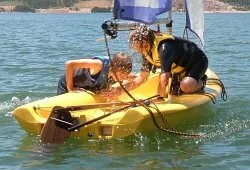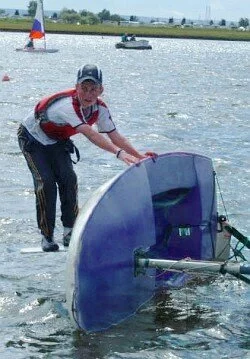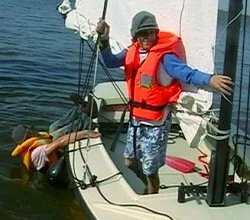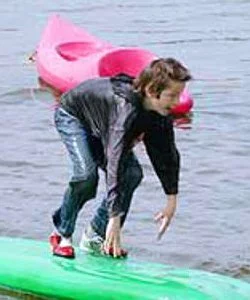 Get in and get going.
|
Dinghy SailingSmall boat sailing can be either competitive, as in collegiate dinghy racing, or purely recreational as when sailing on a lake with family or friends. Dinghies are commonly made from fibreglass, have wood or aluminium spars, and generally a sloop rig (two sails: a mainsail and a jib). Racing dinghies tend to be lighter, have more sail area, and may use a trapeze to allow one or both crew members to suspend themselves over the water for additional stability. Family daysailers tend to be wider with more accommodation space at the expense of speed. You don't have to be in fantastic physical shape to sail, although there's no doubt that a couple of hours of sailing makes for good exercise. Is this expensive?Contrary to popular opinion, dinghy sailing is not an expensive or elitist pastime. Plenty of beautiful second hand boats can be bought for no more than a couple of hundred pounds. The necessary safety gear such as buoyancy aids are also not expensive. Will I get wet?If you just do social sailing without leaving the jetty or marina, you'll probably stay dry unless it rains. In case of foul weather you can always retreat to the club house. Only if you practice sailing as an active water sport would you get wet. Always bring a complete change of clothes for each outing. The day you forget your extra clothes is the day you get wet. |

|
Capsize PracticeCapsize training is exciting fun. The initial realisation you're capsizing and entering the water is the biggest thrill, especially when you're still dry. The adrenaline rush is amazing. While some sailors enjoy it a lot, capsizing is not on everyone's list of favourite things to do when sailing, but knowing what to do and how to recover from a capsize is essential. It should be one of the first things you learn. A capsize in the shallows may get interesting. You get the mast stuck in the mud, manage to pull the boat up right, climb in and suddenly a ton of mud drops from the mast tip onto your head. The best advice we can give is to enjoy it. Capsizing is part of sailing and happens to the best of sailors. When it's a blazing hot day with rather slow sailing and not much wind, you may want to capsize on purpose, just for fun. As with everything in sailing, the more you do it the easier it becomes to do. When you practise the tips below, you'll soon become an expert. Soon you'll master dry capsizing only get a foot wet. |
|
Unjam sheets as soon as you realise the boat is about to capsize. This will save you messing with them in the water. |
Let's Get WetNew sailors are encouraged to capsize their dinghy in a safe location with supervision a few times to become acquainted with their boat's floating properties and the capsize process. For many it is also a new experience to suddenly get all their clothes wet and swim in them. Learn how to right the boat, bail out any water, and reset the sails. In the event of an uncontrolled capsize you are then familiar with the recovery procedure. Most small monohull sailboats can normally be righted by standing or pulling down on the centreboard to lift the mast clear of the water. Depending on the design of the hull, the boat's righting moment will normally take effect once the mast is around 30 degrees from horizontal and the sail clear of the water. Having a crew member lift the end of the mast out of the water may help speed the process, as the greatest challenge of righting a capsized boat is shedding the weight of the water from the sails. The bow of the capsized vessel should be pointed towards the wind so that when the sail starts to lift out of the water the wind can catch underneath the sail and help right the boat. Care should be taken not to let the boat swing all the way over and capsize on the other side, frequently with the crew on the bottom. This is more likely if the boat is not pointed into the wind. Summary
|
 When you capsize a dinghy the sail is lying across the water.
|
Capsize VariationsBefore we move onto actually dealing with capsizes, there are several variations of capsizes to consider: Death Roll can happen when sailing dead downwind. If the boat continually gybes from one side to the other as the wind switches, the rocking can be amplified until the boat capsizes to windward, with the boom and sail in the air, still catching wind, which causes the boat to rotate nose first in the water, and can invert the boat. Dry capsize is when you are quick enough to get over the side of the boat and stand on the centreboard or daggerboard, walking as far back on it as possible to bring the boat back upright. It is not that dry, because while you may only get a foot wet during the capsize, the water has to drain off the sail somewhere, and that's usually on your head! Inversion is when the whole boat goes upside down. A bit trickier to recover from, but unless you have a shallow lake, nothing to worry about. Plain Capsize where every one gets wet! The usual two causes of capsizes both come down to balance. Leeward: Either there will be too much wind in the sails and not enough weight over the windward side, and the sail will fall away from you as the boat flips over into the water. Windward: Or you're sailing along looking good, leaning out the windward side to keep the boat upright All of a sudden the wind dies or changes direction, and the sail comes towards you, taking you for a swim. |
 |
Clothing TipsOnly on very warm days are a long T-shirt and jeans a good choice to protect against sunburn. Beware, wet cotton cools you a fair bit. Some wear jeans and hoodies over a wetsuit to protect the delicate neoprene from deck fittings and other hazards. Overall Wetsuit If you have a wet suit and know you're going into the water, you can even put it on in the shower so there is already a thin layer of warm water inside the wetsuit. Put your rashvest on first while you're still dry; wet Lycra is not so easy to put on. Wear your dinghy suit on top to keep the wind chill off, and you're ready for a dip. Drysuit |


